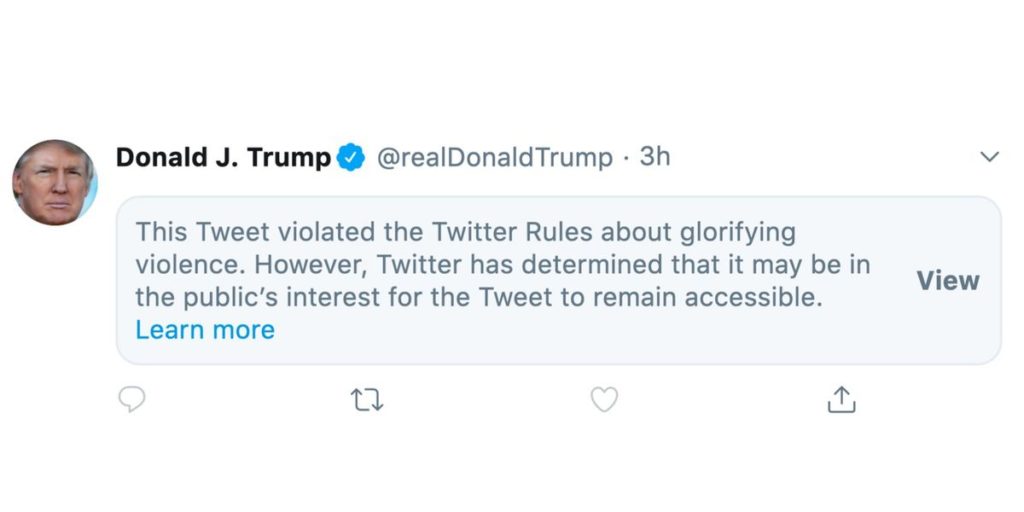
The Mainstreaming of Alt-Right Media
Sarah Riccardi-Swartz
Million MAGA March at US Capitol East, November 14, 2020. Source: Elvert Barnes Photography. (CC BY-SA 2.0).
“we live in a world where the Taliban has a huge presence on Twitter, yet your favorite American President has been silenced. This is unacceptable,” opined former President Trump in a press release issued through his new technology corporation in mid-October 2021. Nodding to his permanent suspension from Twitter in the days following the January 6, 2021, Capitol insurrection, Trump went on to announce the creation of TRUTH Social—a digital space created to support freedom of speech and the open exchange of ideas.
Marshalling the notion of truth as the primary reason for founding his new social media platform signals that Trump is looking for ways to resuscitate his fading “Big Lie.” One of those ways seems to be the curation of a social space that adheres to no truth but his own. With these efforts, Trump reinvigorates the narrative of social suppression and political marginalization often used by those on the far right, suggesting that the only way forward, the only way for patriots to freely express their opinions, is to take part in his new corporate venture. At the end of his comments, Trump proclaimed, “I’m excited to soon begin sharing my thoughts on TRUTH Social and to fight back against Big Tech. Everyone asks me why doesn’t someone stand up to Big Tech? Well, we will be soon!”
The language of rights, in his lawsuits and especially in relationship to TRUTH Social, is a foil for Trump’s larger vision of giving more technological voice to himself and to his ideological base.
As society becomes more intimately tied to and dependent upon digital technology, Americans have become increasingly concerned over the role technological corporations and platforms play in our digitized world, often calling for reform. Data privacy concerns, ethics violations, and the role of internet giants as potential social disciplinarians, have spurred an increasing interest in utilizing anti-trust laws to rein in digital monopolies that possess excessive power and mechanisms of public control. To say the least, there are deep social, ethical, and political concerns over the role of technology in our daily lives.
Yet, these are not the type of concerns or ethical battles Trump is tackling with his new media corporation and platform. Rather, Trump is concerned, on an individual level, that his First Amendment rights have been violated. While Trump’s summer 2021 lawsuit against Facebook, Twitter, and Google for wrongful censorship and infringement on his freedom of speech still lingers in the courts, the former reality star and president is using technology once again as his bully pulpit. The language of rights, in his lawsuits and especially in relationship to TRUTH Social, is a foil for Trump’s larger vision of giving more technological voice to himself and to his ideological base.

Trump’s grousing about his de-platforming from Twitter, and his use of the courts to try and regain his vocal space and followers on public platforms, is a window onto the far right’s discontent with technology and simultaneous impulse to use it as a way to marshal their ideological, often religiously inclined, bases. Yet Trump is not alone in his need for and desire to transform social media. Reacting to the technological crackdown on conspiracy theories, hate speech, and dis/misinformation, far right ideologues have begun looking for spaces where their ideas, opinions, conspiracy theories, and even violent political imaginaries, can take shape freely. The far right, as a growing ideological collective, is looking for a digital alternative to mainstream media platforms where they are viewed as social outliers; they are seeking alternative spaces where their radical ideas, conversations, and events will be viewed as normative, as mainstream.
To be certain, alt-media already exists. Andrew Torba’s Gab, a platform with an emphasis on free speech, has long been a favorite of Christian nationalists, political reactionaries of all stripes, and anti-Semitic conspiracy theorists. Telegram, a Russian owned media platform, is used by former president Trump and other far right politicians, neo-Nazis, anti-vaccine advocates. Along with Parler and Gettr, Gab and Telegram have been successful in creating media spaces that have wide usership with political outliers. Alt-media platforms are not an invention of the twenty-first century; they are a recapitulation of successful conservative media worlds that helped create and sustain partisan, even polarized, audiences.
As the ideological voracity of the far right increases, their media content becomes more volatile, more weaponized, and more transparent in its ill intent, which makes the use of mainstream media untenable for their political malintent.
The United States has a long history of conservative and right-wing media content, often religiously inclined, hosted through print, radio, television, and digital platforms. From William F. Buckley to Rush Limbaugh, the twentieth century saw a wide range of ideologically conservative, tech savvy public figures using media to spread their political messages, party values, and, often, a curatorial moral rubrics that might expedite their revision of the social. Many of those key figures, seemingly paved the way for media polarization and the rise of alt-right media celebrities today. The foothold that figures such as Ben Shapiro, Alex Jones, Nicholas Fuentes, Marjorie Taylor Greene, and even Jordan Peterson have in right-wing and alt-right social media circles may not have been possible without the technological labor of their predecessors. As the ideological voracity of the far right increases, their media content becomes more volatile, more weaponized, and more transparent in its ill intent, which makes the use of mainstream media untenable for their political malintent. At the same time, using mainstream media often provides them the social respectability or acceptability they need to continue growing their audiences and bases. Perhaps that is what TRUTH social is all about.
Trump’s TRUTH Social goes one step beyond the current alt-media platforms in its use of truth rhetoric as a lure. It appeals to potential users who feel as if their opinions, beliefs, and ideas cannot or should not be shared freely on Facebook, Twitter, YouTube, and Instagram. This appeal to truth, particularly in our post-Truth moment, seemingly positions Trump’s media platform as safe space for his followers and co-travelers, who might view the mainstream social media offerings as spaces of cybernetic censorship. Yet, in spite of Trump’s heavy focus on freedom, truth, and independent media formations, the Terms of Service for Truth Social (a product of Trump Media & Technology Group) indicates that freedom of speech on the site is limited, noting that users are not allowed to “disparage, tarnish, or otherwise harm, in our opinion, us and/or the Site.” The blatant dismissal of dissent is not simply an expression of Trump’s inability to handle critique in his new digital home; rather, it is a manifestation of his authoritarian technique. Using the language of truth and freedom, TRUTH Social creates a space in which freedom is curated, controlled, and, ultimately, censored. Time will tell if users will be censored over political content, misinformation, and conspiracy theories, or if the only unforgivable sin on the site will be those committed against Trump and his company through critique.

The announcement over TRUTH Social certainly reinvigorates our interest in Trump’s effect on American sociality in digital spaces, but it also gestures to larger, broader issues of conspiracism and political radicalization, the prominence of Christian nationalism ideologies on social media, and the digitization of social communication. Certainly, TRUTH Social has a public presence in our national consciousness because of its founder. Yet, far-right communities are already in conversation with each other via mainstream social media and on the dark web. As a scholar who writes about religion, media, and technology, I see these communications first-hand on a daily basis. In my own research on far-right Russian Orthodox communities in the United States and their digital movements, it is evident that current media modalities are vehicles through which they connect and spread dis/misinformation. The rapid, often instantaneous, connections forged by community members through media platforms means that the social discourse of both religion and politics is shifting, and with that shift comes a transformation in how political, social, and theological authority is gained, assessed, or refused. Among far-right Orthodox Christians, I have found that virtually mediated encounters provide global avenues for religio-political solidarity and transformation, while also serving as gateways to conspiratorial content and propaganda that have increasingly become part of digital and public social discourse used by far-right compatriots.
Ideological beliefs shared by far-right Orthodox Christians on Twitter are part of the larger circulation of radicalized conservative politics that have become more legible around the world through processes of digital globalization. Media are mechanisms through which social connectivity becomes easier, with the distance being covered through a few simple keystrokes. This is, perhaps, the most terrifying aspect of TRUTH Social—it provides yet another platform for users to have ready access to potentially oppressive, hateful, and even violent ideas with seemingly far less oversight than on mainstream social media outlets. That, of course, creates the perfect digital incubator for ideas, manifestos, and content that can easily be mainstreamed in daily life with damning and potentially horrific results.
Given the ongoing investigations into Trump’s media group by the US Securities and Exchange Commission, it is unclear if TRUTH social will ever fully launch. Despite the investigations, Trump Media announced recently that Republican Representative Devin Nunes, a supporter of Trump through both the Russian election probes of 2016 and the impeachment in 2019, would become the company’s CEO in 2022. In the press release regarding Nunes, Trump noted, “Congressman Devin Nunes is a fighter and a leader. He will make an excellent CEO of TMTG. Devin understands that we must stop the liberal media and Big Tech from destroying the freedoms that make America great. America is ready for TRUTH Social and the end to censorship and political discrimination.” Trump’s emphasis on defeating the so-called liberal media, is a reminder that TRUTH Social is but a digital extension of his authoritarian politics while in office. It is ironic that Trump, a purveyor of the “Big Lie,” would use truth as the name for his new media world. In the end, it seems as if truth functions as Trump’s gloss for reactive ideology. For Trump, truth is not about the preservation of a shared social reality, nor is it about fleeing away from the growing truth divide; rather, it is about curation, control, and combat. Whether or not TRUTH Social succeeds or fails, it is but another indication of how mainstream the far right has seemingly become in the American public sphere.

Sarah Riccardi-Swartz is a postdoctoral fellow in the Luce-Funded Recovering Truth: Religion, Journalism, and Democracy in a Post-Truth Era project in the Center for the Study of Religion and Conflict at Arizona State University. An anthropologist, scholar of American religion, and trained documentary filmmaker, she specializes in social politics, media, race, and Orthodox Christianity. She is the author of Between Heaven and Russia: Religious Conversion and Political Apostasy in Appalachia.
Recommended Citation
Riccardi-Swartz, Sarah. “The Mainstreaming of Alt-Right Media.” Canopy Forum, December 14, 2021. https://canopyforum.org/2021/12/14/the-mainstreaming-of-alt-right-media/.

